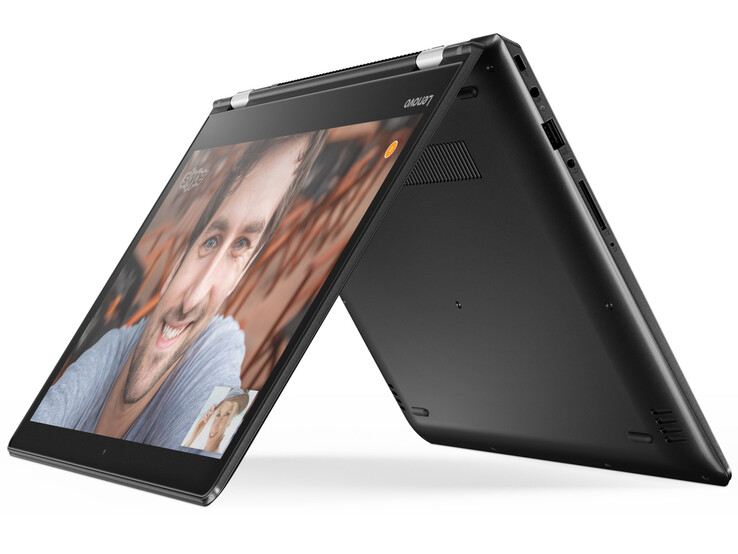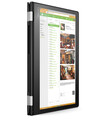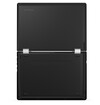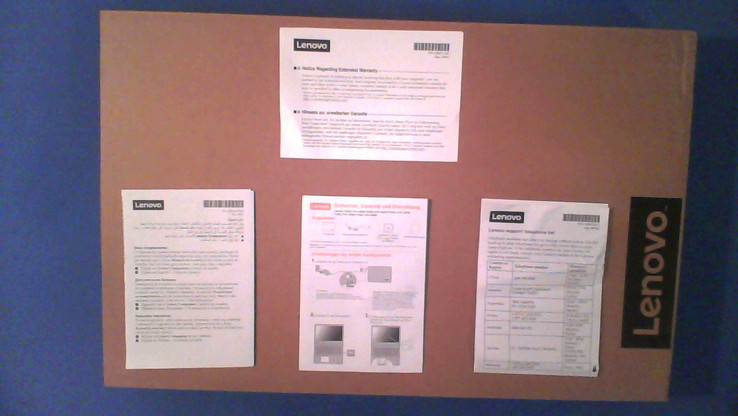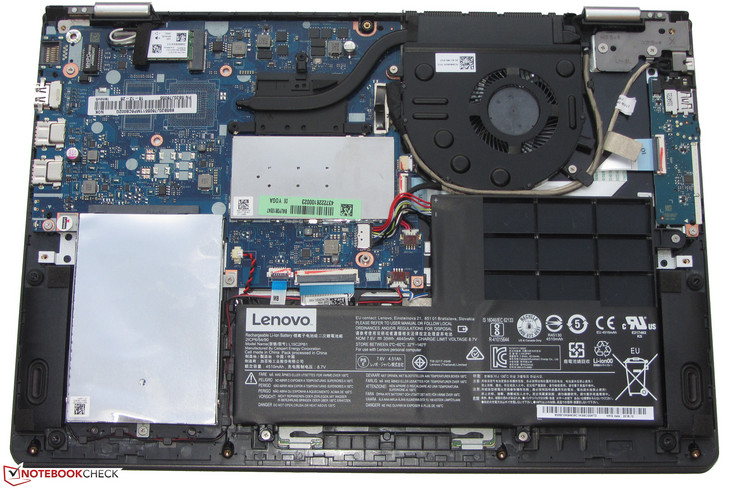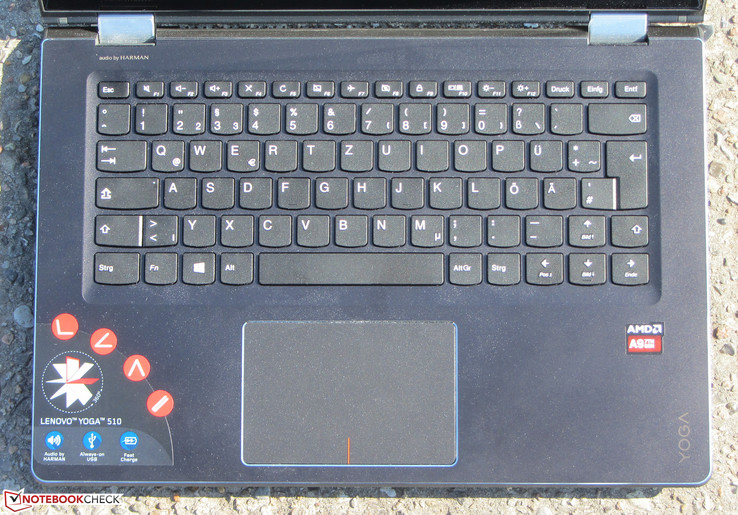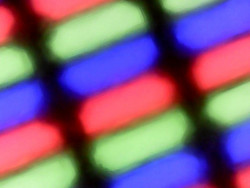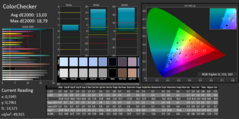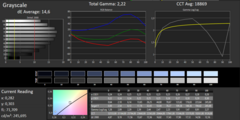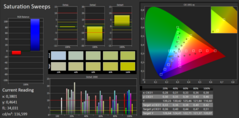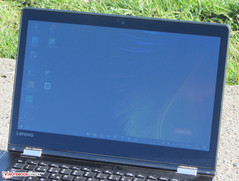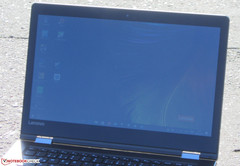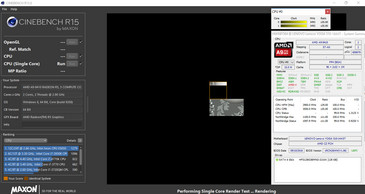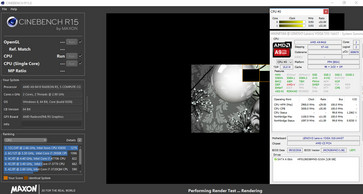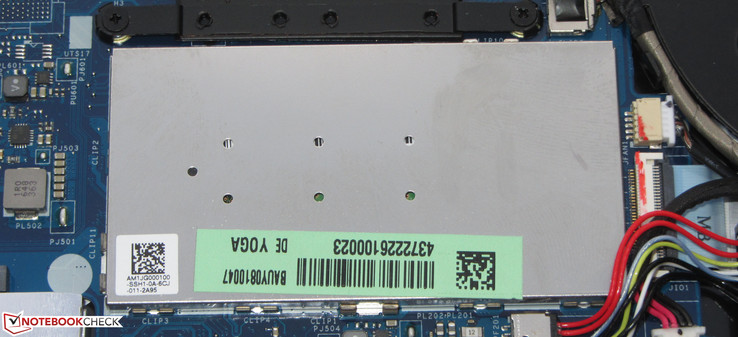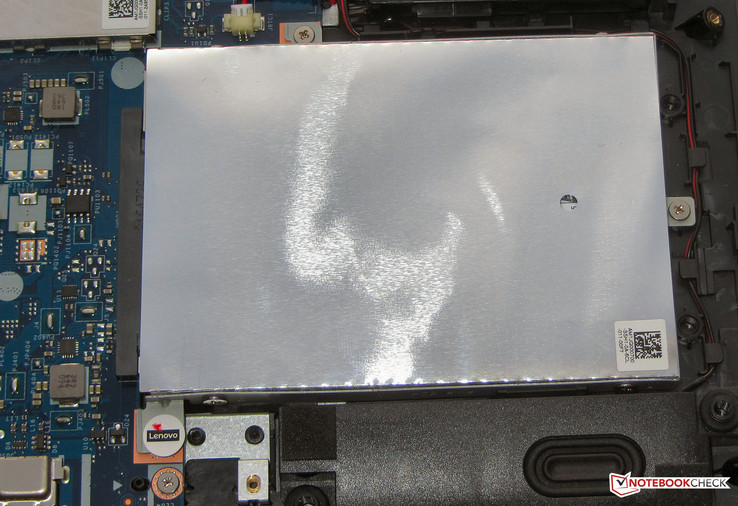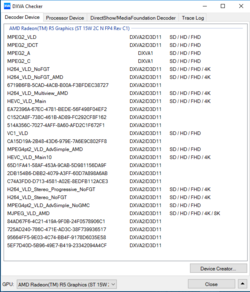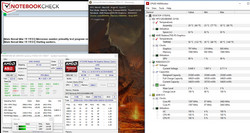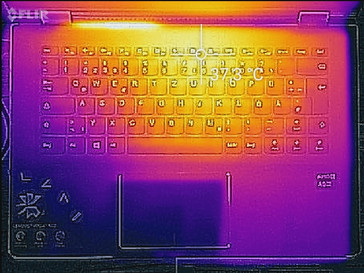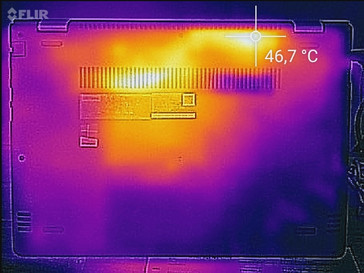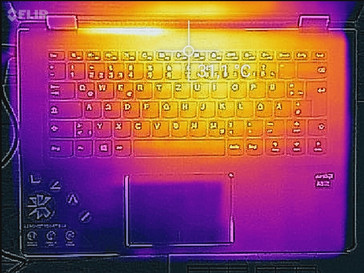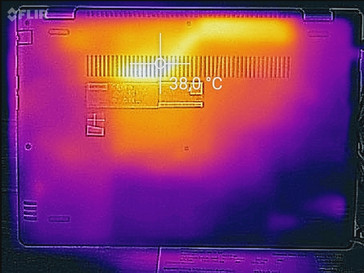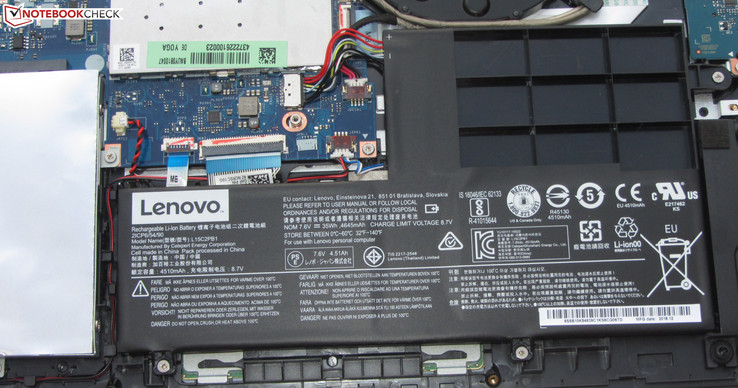Lenovo Yoga 510-14AST (A9-9410, HD) Convertible Review

For the original German review, see here.
Lenovo delivers a 14-inch convertible called Yoga 510-14AST. It is the identically built sister model of the Yoga 510-14IKB that we have tested. While the 14IKB models come with Intel's Kaby Lake processors, the 14AST devices are furnished with AMD's APUs from the latest Stoney Ridge generation. There are no direct competitors in our database. The Yoga can logically compete with HP's Pavilion x360 13 and Acer's Spin 5 SP513-51 13.3-inch convertibles. Their prices come quite close to that of the Yoga.
Case
Lenovo uses a completely black casing made mostly of plastic for its Yoga. Only the base unit's upper side is metal. The laptop does not have a maintenance hatch and the base tray would have to be removed to access the innards - but more about that later.
Lenovo presents a well-built device that does not have any apparent flaws. The gaps are even and material transitions are not palpable. It does not look quite as good with the stability. The base unit can be flexed a bit on the keyboard's sides and below the touchpad. It is also possible to twist the base unit marginally. However, this is still acceptable in view of the price level.
The lid can also be warped a bit, though the image does not distort. Image distortions only appear when pressure is applied to the lid's back. The hinges have a firm grip on the lid although they cannot prevent it from rocking. Opening the lid with one hand is only possible with strong jerking.
As common among many convertibles, the power button is situated on the device's side - it is on the right in this case. The absence of volume control is unusual.
It should not be surprising that the Yoga is a bit bigger and somewhat heavier than its rivals. After all, they are 13.3-inch devices. However, the difference is marginal.
Connectivity
The Yoga does not present any surprises in terms of interfaces. Two of the three Type-A USB ports operate in the USB 3.1 Gen.1 standard. The laptop does not provide a Type-C port. The interfaces are on the rear of both sides. Thus, the area beside the wrist rest remains free of cables in laptop mode.
SD Card Reader
The Yoga's memory card reader achieves a maximum transfer rate of 86.7 MB/s when copying large data blocks. Transferring 250 JPG image files (approx. 5 MB each) is performed at a speed of 64.1 MB/s. Thus, the reader is located in the upper midfield. We test the memory card reader with a Toshiba Exceria Pro SDXC 64 GB UHS-II reference card.
| SD Card Reader | |
| average JPG Copy Test (av. of 3 runs) | |
| HP Pavilion x360 13-u102ng | |
| Lenovo Yoga 510-14AST | |
| Lenovo Yoga 510-14IKB | |
| maximum AS SSD Seq Read Test (1GB) | |
| HP Pavilion x360 13-u102ng | |
| Lenovo Yoga 510-14AST | |
| Lenovo Yoga 510-14IKB | |
Communication
Lenovo furnishes the Yoga with a Wi-Fi module that carries a chip by Qualcomm (QCA9377). In addition to the 802.11 a/b/g/n Wi-Fi standards, it also supports the fast ac standard. The transmission speeds that we determined in ideal conditions (no other Wi-Fi devices in the vicinity, short distance between the laptop and server PC) were moderate at most. A Gigabit Ethernet chip from Realtek's well-known RTL8168/8111 family takes care of cabled network connections. As always, it does an impeccable job.
| Networking | |
| iperf3 transmit AX12 | |
| Acer Spin 5 SP513-51 | |
| Lenovo Yoga 510-14AST | |
| iperf3 receive AX12 | |
| Acer Spin 5 SP513-51 | |
| Lenovo Yoga 510-14AST | |
Webcam
Accessories
The laptop only comes with the usual accessories (quick start poster, warranty conditions).
Maintenance
The laptop's base tray has to be removed to access the innards. Ten screws have to be released on the underside. There are no screws under the rubber stoppers. The base tray can then be removed with a putty knife. The user can access the working memory bank, SSD, Wi-Fi module, fan, and battery.
Warranty
Lenovo gives its Yoga a two-year warranty. Upgrading to a three-year warranty is possible for just 10 Euros (~$11) in some online shops.
Please see our Guarantees, Return Policies and Warranties FAQ for country-specific information.
Input Devices
Keyboard
In contrast to the keyboard in the sister model, the chiclet keyboard of our present review sample is not backlit. The flat, lightly roughened keys have a medium drop and clear pressure point. The keyboard does not yield when typing on it. In total, Lenovo installs a surprisingly good keyboard that is suitable even for frequent typing. However, the layout needs a bit of getting used to: The arrow-up key is where the right shift key usually is. The latter is situated on the right of it. Thus, the arrow key is often pressed although the shift key is wanted. Furthermore, the right shift key is narrower than in other laptops.
Touchpad
Lenovo furnishes the Yoga with a multi-touch ClickPad with a surface of approximately 10.5 x 7 cm (~4.1 x 2.8 in). Thus, there is enough room for using gestures. The diverse gestures can be turned on and off individually in the pad's configuration menu. The pad's sleek surface does not stop the finger from gliding. The pad responds to inputs even in its corners. It has a short drop and clear pressure point.
Touchscreen
The Yoga's touchscreen supports 10 touch points. It responded instantaneously to inputs and did not cause problems. The screen can be used either with the fingers or with an active stylus.
Display
| |||||||||||||||||||||||||
Brightness Distribution: 88 %
Center on Battery: 242 cd/m²
Contrast: 390:1 (Black: 0.62 cd/m²)
ΔE ColorChecker Calman: 13.03 | ∀{0.5-29.43 Ø4.78}
ΔE Greyscale Calman: 14.6 | ∀{0.09-98 Ø5}
52% sRGB (Argyll 1.6.3 3D)
33% AdobeRGB 1998 (Argyll 1.6.3 3D)
35.28% AdobeRGB 1998 (Argyll 3D)
51.4% sRGB (Argyll 3D)
34.15% Display P3 (Argyll 3D)
Gamma: 2.22
CCT: 18869 K
| Lenovo Yoga 510-14AST TN LED, 1366x768, 14" | Lenovo Yoga 510-14IKB IPS, 1920x1080, 14" | HP Pavilion x360 13-u102ng IPS, 1920x1080, 13.3" | Acer Spin 5 SP513-51 IPS LED, 1920x1080, 13.3" | |
|---|---|---|---|---|
| Display | 22% | 15% | 17% | |
| Display P3 Coverage (%) | 34.15 | 41.78 22% | 39.43 15% | 39.99 17% |
| sRGB Coverage (%) | 51.4 | 62.9 22% | 59.1 15% | 59.5 16% |
| AdobeRGB 1998 Coverage (%) | 35.28 | 43.17 22% | 40.76 16% | 41.32 17% |
| Response Times | -5% | 30% | 14% | |
| Response Time Grey 50% / Grey 80% * (ms) | 70 ? | 53 ? 24% | 38 ? 46% | 56 ? 20% |
| Response Time Black / White * (ms) | 29 ? | 39 ? -34% | 25 ? 14% | 27 ? 7% |
| PWM Frequency (Hz) | 350 ? | |||
| Screen | 37% | 39% | 49% | |
| Brightness middle (cd/m²) | 242 | 243 0% | 277 14% | 245 1% |
| Brightness (cd/m²) | 224 | 248 11% | 263 17% | 233 4% |
| Brightness Distribution (%) | 88 | 91 3% | 88 0% | 87 -1% |
| Black Level * (cd/m²) | 0.62 | 0.32 48% | 0.31 50% | 0.21 66% |
| Contrast (:1) | 390 | 759 95% | 894 129% | 1167 199% |
| Colorchecker dE 2000 * | 13.03 | 5.44 58% | 5.57 57% | 4.2 68% |
| Colorchecker dE 2000 max. * | 18.79 | 9.73 48% | 13.6 28% | 8.75 53% |
| Greyscale dE 2000 * | 14.6 | 4.74 68% | 4.56 69% | 3.94 73% |
| Gamma | 2.22 99% | 2.38 92% | 2.28 96% | 2.66 83% |
| CCT | 18869 34% | 7799 83% | 6648 98% | 6096 107% |
| Color Space (Percent of AdobeRGB 1998) (%) | 33 | 39.6 20% | 38 15% | 38 15% |
| Color Space (Percent of sRGB) (%) | 52 | 62.5 20% | 59 13% | 59 13% |
| Total Average (Program / Settings) | 18% /
28% | 28% /
33% | 27% /
38% |
* ... smaller is better
Screen Flickering / PWM (Pulse-Width Modulation)
| Screen flickering / PWM not detected | ||
In comparison: 53 % of all tested devices do not use PWM to dim the display. If PWM was detected, an average of 8108 (minimum: 5 - maximum: 343500) Hz was measured. | ||
The screen does not do a good job in color reproduction, either. The panel presents a DeltaE 2000 color shift of 13.03 in delivery state. A rate less than 3 would be desirable. Furthermore, the screen has a visible bluish tint. The AdobeRGB and sRGB color spaces cannot be displayed. The coverage rates are 33 percent (AdobeRGB) and 52 percent (sRGB).
The color reproduction can be improved slightly with the color profile that we provide. The profile should only be used when exactly the same screen model (manufacturer and model number) is installed as in our review sample. Otherwise, the color reproduction could worsen even more. Screens from different manufacturers are often used within a laptop series.
Display Response Times
| ↔ Response Time Black to White | ||
|---|---|---|
| 29 ms ... rise ↗ and fall ↘ combined | ↗ 23 ms rise | |
| ↘ 6 ms fall | ||
| The screen shows relatively slow response rates in our tests and may be too slow for gamers. In comparison, all tested devices range from 0.1 (minimum) to 240 (maximum) ms. » 76 % of all devices are better. This means that the measured response time is worse than the average of all tested devices (20.2 ms). | ||
| ↔ Response Time 50% Grey to 80% Grey | ||
| 70 ms ... rise ↗ and fall ↘ combined | ↗ 32 ms rise | |
| ↘ 38 ms fall | ||
| The screen shows slow response rates in our tests and will be unsatisfactory for gamers. In comparison, all tested devices range from 0.165 (minimum) to 636 (maximum) ms. » 99 % of all devices are better. This means that the measured response time is worse than the average of all tested devices (31.6 ms). | ||
Lenovo furnishes the Yoga with a viewing angle dependent TN panel. Thus, the screen is not legible from every position. The Yoga display is not easy to read outdoors. The combination of low brightness, low contrast and glossy surface prevent this.
Performance
Lenovo's Yoga 510-14AST is a 14-inch convertible. The installed AMD APU has enough computing power for office and Internet applications. Our review sample is priced at about 500 Euros (~$533). Two other versions with a dedicated Radeon R5 M430 graphics core were available at test time. The identically built Yoga 510-14IKB series expands the lineup.
Processor
Lenovo installs AMD's A9-9410 into our review sample. It is a model from the new Stoney Ridge generation. The CPU part consists of a dual-core processor that clocks at a base speed of 2.9 GHz. The clock can be boosted to 3.5 GHz via Turbo. The APU's TDP of 15 watts is on par with Intel's ULV processors. The processor performed our CPU tests at 3.2 to 3.5 GHz (single thread and multithread).
We loop the Cinebench R15's multithread test for approximately 30 minutes to examine whether the Turbo is permanently utilized. The Yoga's scores are throughout the same. Thus, there is no performance loss.
In total, AMD's processor delivers enough computing power for office and Internet applications. A look at our comparison chart shows that the CPU's single-thread performance is roughly on par with Intel's Core i3 processors from the Haswell generation. Intel's models have a clear advantage in multithread performance. The reason: The Core i3 processors support Hyperthreading (one core can process two threads), but AMD's processors do not.
| Cinebench R11.5 | |
| CPU Multi 64Bit | |
| HP Pavilion x360 13-u102ng | |
| HP Pavilion x2 12-b000ng | |
| Acer Aspire ES1-332-P91H | |
| Medion Akoya S4217T MD98599 | |
| Lenovo M30-70 | |
| Lenovo Yoga 510-14AST | |
| HP 250 G5 Y1V08UT | |
| CPU Single 64Bit | |
| HP Pavilion x360 13-u102ng | |
| HP Pavilion x2 12-b000ng | |
| Lenovo Yoga 510-14AST | |
| Medion Akoya S4217T MD98599 | |
| Lenovo M30-70 | |
| Acer Aspire ES1-332-P91H | |
| HP 250 G5 Y1V08UT | |
| Geekbench 3 | |
| 32 Bit Single-Core Score | |
| HP Pavilion x360 13-u102ng | |
| HP Pavilion x2 12-b000ng | |
| Lenovo Yoga 510-14AST | |
| Lenovo B50-70 MCC2GGE | |
| Acer Aspire ES1-332-P91H | |
| 32 Bit Multi-Core Score | |
| HP Pavilion x360 13-u102ng | |
| HP Pavilion x2 12-b000ng | |
| Acer Aspire ES1-332-P91H | |
| Lenovo B50-70 MCC2GGE | |
| Lenovo Yoga 510-14AST | |
| Geekbench 4.0 | |
| 64 Bit Single-Core Score | |
| HP Pavilion x360 13-u102ng | |
| Lenovo Yoga 510-14AST | |
| Acer Aspire ES1-332-P91H | |
| 64 Bit Multi-Core Score | |
| HP Pavilion x360 13-u102ng | |
| Acer Aspire ES1-332-P91H | |
| Lenovo Yoga 510-14AST | |
System Performance
Thanks to the installed SSD, the laptop runs quickly and smoothly; we did not encounter problems. The PCMark benchmark scores are good. The Yoga has enough computing power for office and Internet applications. It is not possible to increase its total performance.
| PCMark 7 Score | 3814 points | |
| PCMark 8 Home Score Accelerated v2 | 2670 points | |
| PCMark 8 Creative Score Accelerated v2 | 2898 points | |
| PCMark 8 Work Score Accelerated v2 | 3728 points | |
Help | ||
| PCMark 8 | |
| Home Score Accelerated v2 | |
| Lenovo Yoga 510-14IKB | |
| HP Pavilion x360 13-u102ng | |
| Acer Spin 5 SP513-51 | |
| Lenovo Yoga 510-14AST | |
| Work Score Accelerated v2 | |
| Acer Spin 5 SP513-51 | |
| HP Pavilion x360 13-u102ng | |
| Lenovo Yoga 510-14AST | |
Storage Device
Lenovo furnishes the Yoga with a solid-state drive by HFS. It is a 2.5-inch model with a total capacity of 128 GB. Roughly 80 GB of that can be used. The Windows installation and recovery partition reserve the rest of the storage capacity. The SSD's transfer rates are good in total. However, it is not the fastest of its kind as it is an entry-level model. This is not surprising in view of the Yoga's price level.
| Lenovo Yoga 510-14AST | Lenovo Yoga 510-14IKB Samsung MZYTY256HDHP | HP Pavilion x360 13-u102ng HGST Travelstar 5K1000 HTS541010A7E630 | |
|---|---|---|---|
| CrystalDiskMark 3.0 | 61% | -87% | |
| Read Seq (MB/s) | 434.6 | 518 19% | 104.8 -76% |
| Write Seq (MB/s) | 207.7 | 476.5 129% | 91 -56% |
| Read 512 (MB/s) | 356.3 | 408 15% | 20.67 -94% |
| Write 512 (MB/s) | 195.6 | 274.5 40% | 45.05 -77% |
| Read 4k (MB/s) | 26.71 | 35.66 34% | 0.215 -99% |
| Write 4k (MB/s) | 56.8 | 106.7 88% | 1.037 -98% |
| Read 4k QD32 (MB/s) | 176.3 | 368.7 109% | 0.968 -99% |
| Write 4k QD32 (MB/s) | 163.3 | 246.3 51% | 1.09 -99% |
Graphics Card
The Radeon R5 (Stoney Ridge) graphics unit is responsible for video output. It supports DirectX 12 and clocks at up to 800 MHz. The 3DMark benchmarks scores place the GPU roughly on the same level as Intel's HD Graphics 520 graphics unit. It is not possible to increase its performance by activating the dual-channel mode. Firstly, the installed memory controller only supports single-channel mode and secondly, the Yoga only has one working memory bank.
The GPU has a decoder (Unified Video Decoder 6) that unloads the processor when videos are played. It supports all common formats, such as H.264 and HEVC/H.265. The CPU load remained slightly below 40 percent when we played our test video (4K, H.265, 60 FPS).
| 3DMark 06 Standard Score | 5141 points | |
| 3DMark Vantage P Result | 3346 points | |
| 3DMark 11 Performance | 1199 points | |
| 3DMark Ice Storm Standard Score | 36896 points | |
| 3DMark Cloud Gate Standard Score | 3010 points | |
| 3DMark Fire Strike Score | 712 points | |
| 3DMark Fire Strike Extreme Score | 344 points | |
| 3DMark Time Spy Score | 274 points | |
Help | ||
| 3DMark 11 - 1280x720 Performance GPU | |
| Lenovo Yoga 510-14IKB | |
| HP Pavilion x360 13-u102ng | |
| Acer Spin 5 SP513-51 | |
| Lenovo Yoga 510-14AST | |
| 3DMark | |
| 1280x720 Cloud Gate Standard Graphics | |
| HP Pavilion x360 13-u102ng | |
| Acer Spin 5 SP513-51 | |
| Lenovo Yoga 510-14IKB | |
| Lenovo Yoga 510-14AST | |
| 1920x1080 Fire Strike Graphics | |
| Lenovo Yoga 510-14IKB | |
| Lenovo Yoga 510-14AST | |
| HP Pavilion x360 13-u102ng | |
| Acer Spin 5 SP513-51 | |
Gaming Performance
AMD's APU is quite able to render some games smoothly. However, this is limited to using low resolutions and low quality settings, and then primarily games with relatively low hardware requirements can be played. Performance-driven smash hits, such as "Ghost Recon Wildlands" are not playable.
| low | med. | high | ultra | |
|---|---|---|---|---|
| World of Warcraft (2005) | 82.6 | 43.7 | ||
| Deus Ex Human Revolution (2011) | 62.4 | 29 | ||
| The Elder Scrolls V: Skyrim (2011) | 32.7 | 22.2 | 15.4 | |
| Diablo III (2012) | 59.6 | 41.8 | 33.6 | |
| Counter-Strike: GO (2012) | 39.2 | 28.5 | 25 | |
| Dead Space 3 (2013) | 63.9 | 31 | 26.6 | |
| Tomb Raider (2013) | 51.9 | 25.7 | 18.2 | |
| BioShock Infinite (2013) | 43.5 | 26.9 | 22.2 | |
| X-Plane 10.25 (2013) | 31.7 | 17.7 | 9.6 | |
| GRID: Autosport (2014) | 65.1 | 29.7 | ||
| Risen 3: Titan Lords (2014) | 20.9 | 12.9 | ||
| Sims 4 (2014) | 111.9 | 34.3 | ||
| Middle-earth: Shadow of Mordor (2014) | 22.3 | 13.8 | ||
| F1 2014 (2014) | 39 | 30 | ||
| Dragon Age: Inquisition (2014) | 19.3 | 14.8 | ||
| Dirt Rally (2015) | 59.7 | 22 | ||
| Metal Gear Solid V (2015) | 34.1 | 24.9 | ||
| Dota 2 Reborn (2015) | 33.1 | 23.2 | ||
| World of Warships (2015) | 37.7 | 28.8 | ||
| Rainbow Six Siege (2015) | 26.9 | 21.6 | ||
| Rise of the Tomb Raider (2016) | 16.1 | 10.4 | ||
| The Division (2016) | 18.2 | 11.3 | ||
| Civilization 6 (2016) | 29.4 | 12.1 | ||
| Farming Simulator 17 (2016) | 53.4 | 36.1 | ||
| Resident Evil 7 (2017) | 28.6 | 13.2 | ||
| For Honor (2017) | 19.9 | 7.3 | ||
| Ghost Recon Wildlands (2017) | 10.9 | 5.2 |
| BioShock Infinite - 1280x720 Very Low Preset | |
| Lenovo Yoga 510-14AST | |
| Acer Spin 5 SP513-51 | |
| Lenovo Yoga 510-14IKB | |
| HP Pavilion x360 13-u102ng | |
| Acer Aspire ES1-332-P91H | |
| Tomb Raider - 1024x768 Low Preset | |
| HP Pavilion x360 13-u102ng | |
| Lenovo Yoga 510-14AST | |
| Acer Aspire ES1-332-P91H | |
| GRID: Autosport - 1024x768 Ultra Low Preset | |
| Lenovo Yoga 510-14AST | |
| Acer Aspire ES1-332-P91H | |
Emissions
System Noise
The Yoga does not produce an excessive amount of noise over the entire load range. The fan is usually inactive in idle mode and silence prevails. The fan only sped up slightly during the stress test. We measured a maximum noise level of 33.3 dB(A).
Noise level
| Idle |
| 30.4 / 30.4 / 30.4 dB(A) |
| Load |
| 31.3 / 33.3 dB(A) |
 | ||
30 dB silent 40 dB(A) audible 50 dB(A) loud |
||
min: | ||
| Lenovo Yoga 510-14AST A9-9410, Radeon R5 (Stoney Ridge) | Lenovo Yoga 510-14IKB i5-7200U, Radeon R5 M430 | HP Pavilion x360 13-u102ng i5-7200U, HD Graphics 620 | Acer Spin 5 SP513-51 6100U, HD Graphics 520 | |
|---|---|---|---|---|
| Noise | -5% | -5% | -2% | |
| off / environment * (dB) | 30.4 | 29 5% | 30.5 -0% | 30.5 -0% |
| Idle Minimum * (dB) | 30.4 | 29 5% | 31.3 -3% | 30.5 -0% |
| Idle Average * (dB) | 30.4 | 29 5% | 31.3 -3% | 30.5 -0% |
| Idle Maximum * (dB) | 30.4 | 29 5% | 31.6 -4% | 30.6 -1% |
| Load Average * (dB) | 31.3 | 37.3 -19% | 34.2 -9% | 31 1% |
| Load Maximum * (dB) | 33.3 | 43.1 -29% | 37.3 -12% | 36.8 -11% |
* ... smaller is better
Temperature
The Yoga performed our stress test (Prime95 and FurMark run for at least one hour) in the same manner in AC and battery mode. The graphics card runs at full speed (800 MHz), but the processor throttles to 1.4 GHz. The device does not heat up excessively. The temperatures remained below 40 degrees Celsius (104 Fahrenheit) on all measuring points during the stress test.
The CPU's evident throttling should not be of any concern. The CPU utilizes its Turbo in routine use. Our stress test is an extreme scenario that will unlikely occur during everyday use.
(+) The maximum temperature on the upper side is 34.5 °C / 94 F, compared to the average of 35.4 °C / 96 F, ranging from 19.6 to 60 °C for the class Convertible.
(+) The bottom heats up to a maximum of 39 °C / 102 F, compared to the average of 36.8 °C / 98 F
(+) In idle usage, the average temperature for the upper side is 27.1 °C / 81 F, compared to the device average of 30.3 °C / 87 F.
(+) The palmrests and touchpad are cooler than skin temperature with a maximum of 26.3 °C / 79.3 F and are therefore cool to the touch.
(±) The average temperature of the palmrest area of similar devices was 27.9 °C / 82.2 F (+1.6 °C / 2.9 F).
| Lenovo Yoga 510-14AST A9-9410, Radeon R5 (Stoney Ridge) | Lenovo Yoga 510-14IKB i5-7200U, Radeon R5 M430 | HP Pavilion x360 13-u102ng i5-7200U, HD Graphics 620 | Acer Spin 5 SP513-51 6100U, HD Graphics 520 | |
|---|---|---|---|---|
| Heat | -6% | 10% | -0% | |
| Maximum Upper Side * (°C) | 34.5 | 40.1 -16% | 34.6 -0% | 38.3 -11% |
| Maximum Bottom * (°C) | 39 | 46.1 -18% | 36.4 7% | 42.5 -9% |
| Idle Upper Side * (°C) | 30.8 | 28.5 7% | 26.6 14% | 28.7 7% |
| Idle Bottom * (°C) | 33.4 | 31.6 5% | 27.7 17% | 29.4 12% |
* ... smaller is better
Speakers
The Yoga's stereo speakers are situated on the device's underside. They produce a decent sound that lacks bass. The maximum volume is also fairly low.
Lenovo Yoga 510-14AST audio analysis
(-) | not very loud speakers (65 dB)
Bass 100 - 315 Hz
(-) | nearly no bass - on average 24.3% lower than median
(±) | linearity of bass is average (11.4% delta to prev. frequency)
Mids 400 - 2000 Hz
(+) | balanced mids - only 2.6% away from median
(±) | linearity of mids is average (8.2% delta to prev. frequency)
Highs 2 - 16 kHz
(+) | balanced highs - only 2.1% away from median
(±) | linearity of highs is average (8.1% delta to prev. frequency)
Overall 100 - 16.000 Hz
(±) | linearity of overall sound is average (21.8% difference to median)
Compared to same class
» 61% of all tested devices in this class were better, 9% similar, 31% worse
» The best had a delta of 6%, average was 20%, worst was 57%
Compared to all devices tested
» 61% of all tested devices were better, 7% similar, 32% worse
» The best had a delta of 4%, average was 24%, worst was 134%
Apple MacBook 12 (Early 2016) 1.1 GHz audio analysis
(+) | speakers can play relatively loud (83.6 dB)
Bass 100 - 315 Hz
(±) | reduced bass - on average 11.3% lower than median
(±) | linearity of bass is average (14.2% delta to prev. frequency)
Mids 400 - 2000 Hz
(+) | balanced mids - only 2.4% away from median
(+) | mids are linear (5.5% delta to prev. frequency)
Highs 2 - 16 kHz
(+) | balanced highs - only 2% away from median
(+) | highs are linear (4.5% delta to prev. frequency)
Overall 100 - 16.000 Hz
(+) | overall sound is linear (10.2% difference to median)
Compared to same class
» 7% of all tested devices in this class were better, 2% similar, 91% worse
» The best had a delta of 5%, average was 18%, worst was 53%
Compared to all devices tested
» 4% of all tested devices were better, 1% similar, 94% worse
» The best had a delta of 4%, average was 24%, worst was 134%
Frequency diagram in comparison (checkboxes above can be turned on/off!)
Energy Management
Power Consumption
We measured a maximum idle consumption of 9.4 watts. Thus, the Yoga consumes a bit more than its sister model equipped with a Core i5 processor and Full HD panel. The Yoga's energy requirement climbed to just 22 watts during our stress test. CPU throttling becomes evident here. The power supply has a nominal output of 45 watts.
| Off / Standby | |
| Idle | |
| Load |
|
Key:
min: | |
| Lenovo Yoga 510-14AST A9-9410, Radeon R5 (Stoney Ridge) | Lenovo Yoga 510-14IKB i5-7200U, Radeon R5 M430 | HP Pavilion x360 13-u102ng i5-7200U, HD Graphics 620 | Acer Spin 5 SP513-51 6100U, HD Graphics 520 | |
|---|---|---|---|---|
| Power Consumption | -40% | -17% | -1% | |
| Idle Minimum * (Watt) | 3.9 | 3.9 -0% | 4.7 -21% | 4.1 -5% |
| Idle Average * (Watt) | 7.4 | 7.1 4% | 7.2 3% | 6.8 8% |
| Idle Maximum * (Watt) | 9.4 | 7.7 18% | 7.9 16% | 7.9 16% |
| Load Average * (Watt) | 19.2 | 33.4 -74% | 30 -56% | 20.4 -6% |
| Load Maximum * (Watt) | 22.5 | 55.9 -148% | 29 -29% | 26.8 -19% |
* ... smaller is better
Battery Runtime
Our practical Wi-Fi test simulates the load needed for opening websites via a script. The "Balanced" profile is enabled, the energy-saving functions are disabled, and the screen's brightness is dimmed to approximately 150 cd/m². The Yoga achieves a runtime of 5:25 hours in this test. Lenovo's convertible stops the video test after 5:06 hours. The short movie "Big Buck Bunny" (H.264 encoding, 1920x1080 pixels) is looped here. The wireless modules and energy-saving functions are disabled, and the screen's brightness is set to about 150 cd/m².
The Yoga can outperform its Intel-based sister model in minimum and maximum battery life. The sister model has the lead in the practical Wi-Fi test. The Yoga only provides poor runtimes in the tests relevant for practice. Here, the battery's relatively low capacity (35 Wh) becomes evident.
| Lenovo Yoga 510-14AST A9-9410, Radeon R5 (Stoney Ridge), 35 Wh | Lenovo Yoga 510-14IKB i5-7200U, Radeon R5 M430, 35 Wh | HP Pavilion x360 13-u102ng i5-7200U, HD Graphics 620, 41 Wh | Acer Spin 5 SP513-51 6100U, HD Graphics 520, 45 Wh | |
|---|---|---|---|---|
| Battery runtime | -4% | -14% | 16% | |
| Reader / Idle (h) | 14.1 | 12 -15% | 9.3 -34% | 12.5 -11% |
| H.264 (h) | 5.1 | 5.3 4% | ||
| WiFi v1.3 (h) | 5.4 | 6.2 15% | 5.4 0% | 7.7 43% |
| Load (h) | 1.9 | 1.7 -11% | 1.4 -26% | 2.2 16% |
Pros
Cons
Verdict
With the Yoga 510-14AST, Lenovo delivers the affordable version of the Yoga 510-15IKB that we have tested. At a price of approximately 500 Euros (~$533), the Yoga 510-14AST is good 400 Euros (~$427) cheaper than the tested sister model. The new Stoney Bridge APU made a good impression indeed: The CPU has enough power for its intended application (office, Internet), and the GPU competes with Intel's HD Graphics 520 graphics unit and smoothly renders the one or other game.
The Yoga runs quietly over the entire load range and heats up moderately at most. A solid-state drive ensures a fast-running system. Users who need more storage capacity that the 128 GB SSD provides can replace it with a higher-capacity model. The laptop's base tray has to be removed for this. The installed keyboard is appealing overall, and it even allows frequent typing sessions. The battery runtimes are short.
The screen is disappointing. The responsible workers at Lenovo apparently believe that a viewing angle dependent TN panel is a good choice for a convertible.
Furthermore, it is also a dark, low-contrast model that only provides poor color reproduction in delivery state. Lenovo lessens the devices attractiveness considerably with its choice of screen. That is too bad since Lenovo has actually created a rounded device that would have certainly found buyers. It is apparently not possible to choose another model. All 14AST versions available at test time were furnished with this inferior screen - incomprehensible.
Users who want a viewing angle stable panel will have to opt for an Intel-based Yoga model. The Yoga 510-14IKB 80VB0081GE costs 50 Euros (~$53) more and comes with a much stronger Core i3-7100U processor and viewing angle stable Full HD IPS screen. Thus, there is barely a reason for taking an AMD-based model.
Lenovo Yoga 510-14AST
- 03/23/2017 v6 (old)
Sascha Mölck




